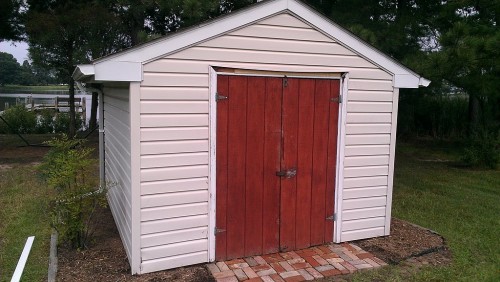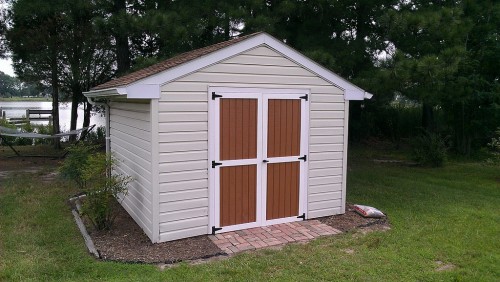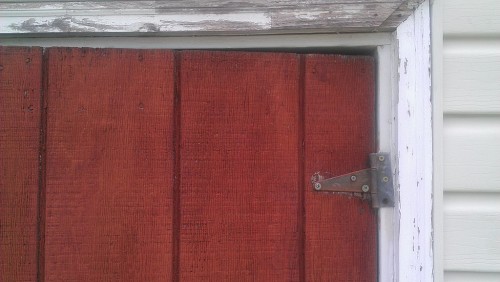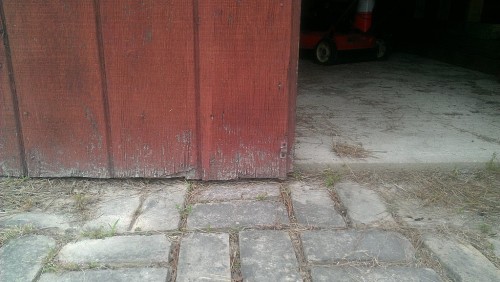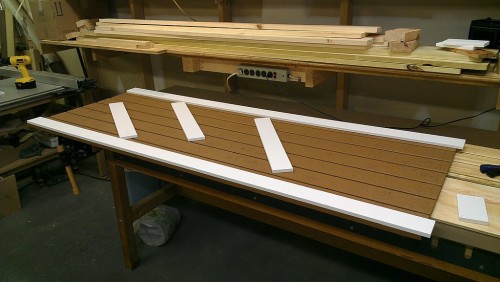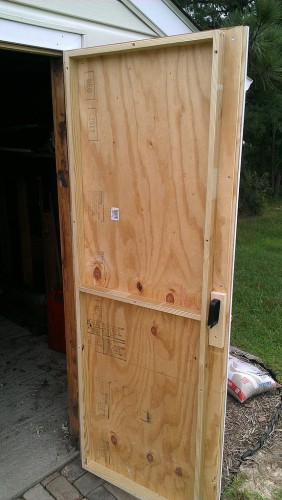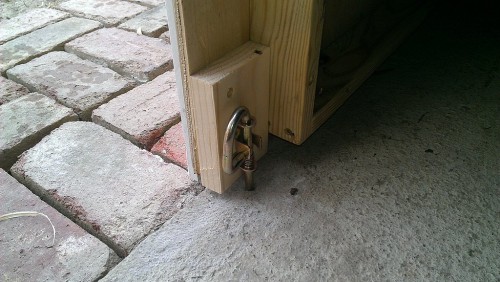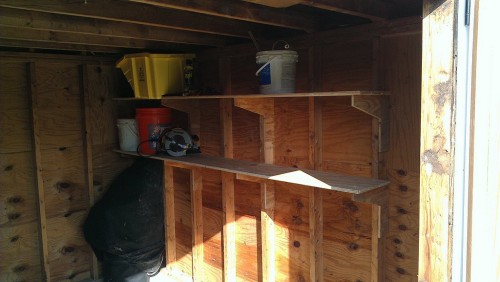When confronted with dilapidated shed doors, one can opt to either repair or replace. In the case of the doors shown below, I opted for replacement. These doors were probably 20 to 30 years old and in dire need of TLC. They were made from T1-11 plywood and painted a garish, ugly primer red that contrasted sharply with the rest of the shed which was tidily clad in white and tan vinyl. The wood was splintered, warped, and hung unevenly in the frame. In short, it was an eyesore.
Imagine the shed with brand new weather resistant doors that fit in with the color scheme of the rest of the shed. I had this vision in mind when I came up with the doors shown below. Like the original doors, these were also made from T1-11 plywood but with 1/2″ thick by 3″ wide PVC edging on all sides. Plus all new hardware all around, including a locking T-handle. I found a Shed Door Hardware Kit on Amazon that provided all the necessary components.
The molding around the old door was weather-beaten and partially decayed. I ripped all of this stuff out and replaced it with decay resistant 3/4″ thick PVC trim. The hinges were askew and bent. These were given the heave-ho and replaced with new hinges that had a rust-resistant coating. And they were mounted properly (well, except for one…)
The bottoms of the old doors were really in bad shape. They extended about 1/2″” too far so that they were frequently exposed to water that tended to pool near the shed entrance. This was exacerbated by the slope of the yard which directed water towards, rather than away, from the shed. As part of the restoration effort, I re-sloped part of the yard to divert water to either side of the shed. I also resloped and reset all of the bricks forming the shed entryway.
The new doors were made from two 4′ by 8′ sheets of T1-11, each ripped to an approximate width of 29″ and then cross-cut to a length of 75-1/2″. The left door had to be about 1/2″ wider than the left to allow for overlap in the middle. Each door was painted brown – somehow I managed to buy just enough paint to apply two light coats to each door. Then, 3″ wide PVC trim was attached to the edges of each door plus one horizontal piece in the middle. These strips were cut from a single piece of trim that was 24″ wide. For the sake of aesthetics (always important with sheds), the attachment screws were inserted from the back of the door.
To provide extra rigidity and take out some of the warp in the panels, I attached 3/4″ x 2″ pieces of pressure treated pine to the back of each door. Although they added a little more weight, these pieces made a big difference as far as making the doors line up with each other.
The top and bottom of the left hand door is secured in the closed position with barrel bolts. These are basically spring-loaded sliding metal rods that fit into 5/16″ diameter holes. A masonry bit was required to drill the bottom hole. The right hand door is then closed and the T-handle turned 90 degrees to fit snugly against the back of the left door. I must say it makes for a nice solid fit.
The new doors make the whole shed look brand new. The only required maintenance should be repainting the panels periodically (is 10 years asking too much?)
After completing the doors, I decided to put the left-over T1-11 material to good use. I made two shelves, each about 12″ wide and supported by plywood brackets. A place for everything and everything in it’s place… By the way, plywood makes for surprisingly strong brackets owing to the alternating grain of each veneer layer.


